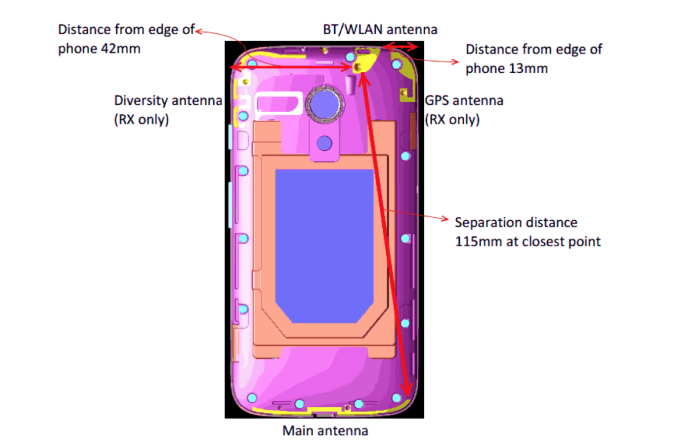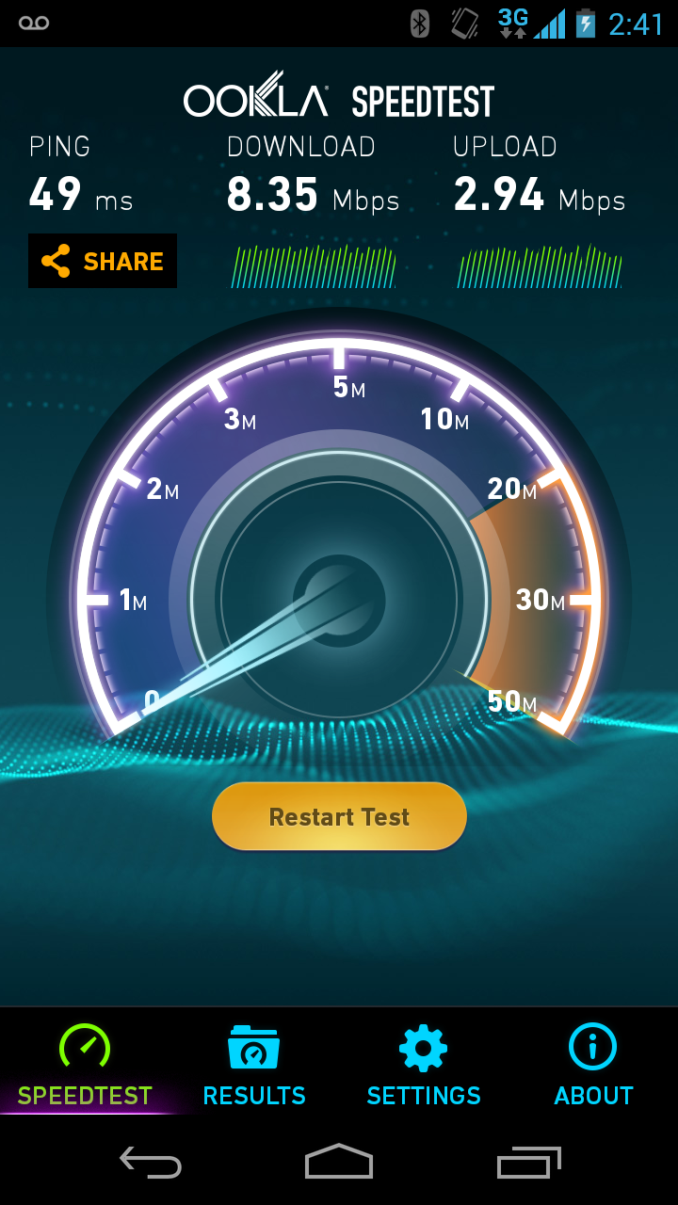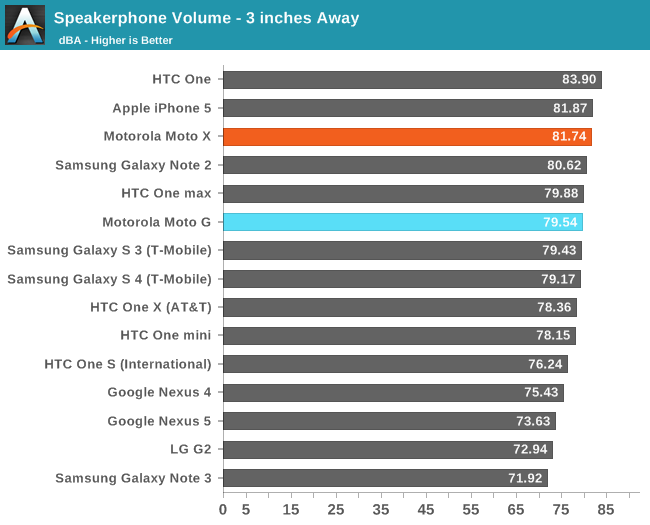Motorola Moto G Review
by Brian Klug on December 18, 2013 2:00 PM EST- Posted in
- Smartphones
- Motorola
- Mobile
- *VA
- Cortex A7
- snapdragon 400
- Moto G
Cellular
The cellular side of the Moto G is an interesting one, at least for those who have kept constantly abreast of wireless banding configurations and the state of mobile RF. At the high end, pentaband WCDMA is now essentially ubiquitous, with parity LTE banding (given the shared nature of ports on the transceiver) and at least a handful more bands for whatever’s appropriate to the region. There’s no global LTE band combination equivalent to quad band GSM or pentaband WCDMA that has emerged quite yet, but it’s getting there, and in the next generation or two we’ll undoubtedly finally see it come to fruition.
|
Moto G (US GSM) |
Moto G (Global GSM) |
Moto G (CDMA) |
|
| Baseband | MSM8x26 - (Up to HSDPA 21.1 Enabled, EVDO Rev.A for CDMA) | ||
| Transceiver | WTR2605/WFR2600 (?) | ||
| GSM | 850/900/1800/1900 MHz | - | |
| CDMA2000 | BC: 0/1/10 | - | 850, 1900 MHz |
| WCDMA |
850, 1700/2100 (AWS), 1900 MHz (Bands 2, 4, 5) |
850, 900, 1900, 2100 MHz (Bands 1,2,5,8) |
- |
| LTE | - | - | - |
The Moto G however comes in a number of different flavors with different band combinations – there’s US GSM, Global GSM, and CDMA. I also suspect there’s at least one more dual SIM variant that we haven’t seen crop up just yet (Update: Apparently this exists already, XT1033 is the dual SIM variant, thanks @evefavretto). On the back case of Moto G there’s a space whose shape matches the microSIM tray at top, and on the board there’s a shield covering pads that are undoubtedly for a microSIM. Interestingly enough Motorola sampled me the Global GSM variant of the Moto G which lacks Band 4. I’ve been using it on T-Mobile successfully however thanks to the relative ubiquity of the 1900 MHz WCDMA carrier in my market. The US GSM variant of the Moto G trades Band 4 for 1 and 8 (2100 and 900 MHz), two popular bands internationally. I’ve seen Moto G erroneously listed as being a pentaband WCDMA phone, which it unfortunately isn’t.

Primary Rx/Tx at bottom, Diversity Rx up top, WLAN/BT, GNSS Rx
Moto G does offer a leg up with receive diversity for CDMA1x/EVDO and HSPA+, something that some HSPA+ flagships from this generation amazingly enough still don’t include. The transceiver is WTR2605 for the primary Rx and Tx ports, and WFR2600 for the additional Rx diversity path. I have no idea what the port configurations look like for WTR2605, but I’d imagine it looks like a cut down WTR1605 of some kind. I have a suspicion that WTR2605 was designed for a quad band UMTS configuration with Bands 1,2,5, and 8, so it might indeed already be port limited in the Global GSM Moto G variant. I also wouldn’t be surprised if there’s some ready made front end module at the front of the whole thing.
Moto G arrives without LTE and instead offers up to single carrier HSPA+ with 64QAM, for up to 21 Mbps on the downlink. Although MSM8x26 itself has a modem block capable of up to dual carrier HSPA+ and category 4 LTE, it seems as though Motorola went for single carrier HSPA+ in the Moto G for time to market reasons, with the LTE and dual-carrier HSPA+ enabled software tree likely slotting in a quarter later than the initial code drop with single carrier HSPA+.


Not bad for single carrier HSPA+ on T-Mobile USA
I’ve been pretty pleased with the cellular performance of the Moto G, even using the variant that lacks Band 4 on T-Mobile USA. Not having LTE made me initially skeptical of it getting operator traction in the US, but it seems as though Motorola has actually had success at least on some prepaid tiers. I’ve been spoiled with LTE devices for a long time now, but single carrier HSPA+ is absolutely still survivable.
WLAN
WiFi connectivity on Moto G is single band 2.4 GHz 802.11n with BT 4.0 and FM receive. On the Moto G, that connectivity is courtesy the new WCN3620 BT/FM/WLAN RF combo chip in a wafer scale package. We’ve now seen WCN3660, the initial dual band combo, then WCN3680 which added 802.11ac, and now WCN3620, the cost reduced version which is single band 802.11n and no doubt offered at a competitive price point with the rest of the platform.
The WLAN/BT stack doesn’t do any antenna sharing and instead has its own transmit and receive path on the top of the Moto G. I don’t have any complaints about WLAN range on the Moto G.
To evaluate performance we turn to the same iPerf test same as always. I was able to attach the Moto G to my network at the 65 Mbps PHY rate that corresponds to long guard interval with a 20 MHz channel.

Performance is pretty decent at just over 50 Mbps. It’s a significant delta over the latest devices with dual band 80 MHz 802.11ac support, but again, totally solid relative to the tier it’s in.
Speakerphone and Noise Canceling
Speakerphone on the Moto G seems to be a big chamber if you take the back off, but there’s a relatively small seal against the whole affair, although the grille has larger holes than Moto X’s relatively tiny ones. Loudness is competitive, but unsurprisingly short of Moto X.

I’d describe Moto G’s speaker as decent, not overly loud or rich sounding.
Dual microphone noise suppression is still a somewhat notable feature at the midrange. In the case of Moto G, Qualcomm’s Fluence package is used in a configuration with the primary microphone at bottom and secondary at very top. I did some digging and also found that Moto G is using Qualcomm’s WCD9302 audio codec which we haven’t seen before, again a more midrange variant. I’ll leave the earphone/line out audio testing for Chris to evaluate.
Noise suppression on the Moto G is decent, but seems to have longer adaptation time than the Moto X. Using the exact same setup, I definitely noticed better rejection on Moto X as well, with less noise being passed through at the same volume level. I should also note that the Moto G does not appear to be AMR-WB enabled on T-Mobile.
GNSS
GNSS onboard the Moto G is the same Gen 8B as we’ve seen on 8974, which translates to support for GPS (USA “Navstar”), GLONASS (Russia), and Beidou (China), although the spec table for Moto G only lists GPS and GLONASS, leading me to believe Beidou might be reserved for devices destined for China. There’s a discrete antenna for GNSS on the Moto G, and I had no issues with getting fast, accurate 3D fixes. I remain impressed with Qualcomm’s GNSS which obviously benefits from integration right into the SoC.










120 Comments
View All Comments
Impulses - Wednesday, December 18, 2013 - link
FLAC on a phone is a massive waste of space... MP3 w/a high enough bitrate as to be indistinguishable take up like 1/10th the space and a large 100-200 disc collection takes an hour or two to transcode (on a modern laptop).apertotes - Wednesday, December 18, 2013 - link
that is true, but it is also true that 1000 songs is a very low number for many people, and having to change your collection every week sucks. So yes, 16 gb may be enough. Of course, even 8gb. If you have no other option, you manage with what you got. But that does not mean that many people will find themselves cursing at the lack of internal space a short time after their purchase.sprockkets - Thursday, December 19, 2013 - link
Use 160kbps ogg vorbis.160kbps = 1.2mb per minute. Avg 4 min a song gives 2560 for 12GiB capacity.
Need more music? Then you are either weird and think you need more than 2500 songs at once so spend $ elsewhere.
bhima - Monday, December 23, 2013 - link
FLAC for your phone? Are you using $600 Grado cans, an amp and DAC with your phone? If you aren't, you literally have zero reason to be using FLAC over 320kbps MP3s. Hell, you'd be hard pressed to notice the difference in 256kbps even with great IEMs or cans unless your powersource/dac is good.flyingpants1 - Friday, December 20, 2013 - link
What kind of stupid person are you? 8GB?Bob Todd - Wednesday, December 18, 2013 - link
Nice timing on the review. I just gave my wife's mother my old N4, and her dad has been looking longingly at it. I was thinking about the Moto G for him, and in truth even it would be overkill. I think a lot of folks, myself included, were wondering what the hell Google was going to do with Motorola (beyond patent acquisition and some potential gains for Google TV...before selling the division responsible for the STB business anyway). It looks like they are going to carve out a really nice niche in the midrange. A device like this could be huge in places like India. CPU performance is more than reasonable for the price, NAND performance is good, and I was just plain surprised by the battery life showing. Excellent device for the off contract price.Hrel - Wednesday, December 18, 2013 - link
I wonder if this will support those new LTE frequences on Virgin Mobile. Assuming of course the Delay on Virgin Mobile is due to adding LTE.I hope that's the case SO badly!
Anyone paying over $35/month for their smartphone is part of the problem. STOP doing that people. Fucking Verizon, with it's $130/month bullshit.
erple2 - Sunday, December 22, 2013 - link
The problem I have with Virgin is that they piggyback off Sprint, which has the worst coverage in my area of the big four. Plus I average about 500 minutes a month. So I'm looking at their $45 plan. Or I can go with another mvno that piggybacks off the gsm providers for the same price but with unlimited calls. And get much better coverage/speeds in my area. Which I do. Either way, this Motorola G looks like a great phone to have.gus6464 - Wednesday, December 18, 2013 - link
Moto X and G are exceptional phones that definitely got me drinking the Motorola koolaid.darwinosx - Wednesday, December 18, 2013 - link
I don't know who this phone is for especially in the US. You are going to pay LTE prices and get rapidly diminishing 3G service. You can get top end smartphones for good pieces online etc...I just can't see the market. Even the Moto X which as an iPhone user I still think is a great phone, is not selling well at all. Moto